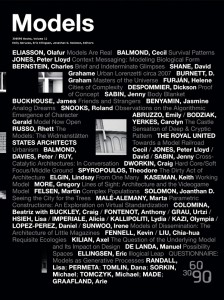
Kilian, Axel, “The Question of the Underlying Model and its Impact on Design”, in Abruzzo, Emily et al. (Ed.), Models, 306090 Books, Volume 11, 306090 Inc, New York, 2007, p. 208
This is an article in a special 306090 publication themed Models. I have referred to Kilian in my thesis, based on his PhD dissertation, but this article is interesting in that it tries to take in the complexity that arises as contemporary practice works with computational techniques, and in this sense Kilian emphasizes the role of the model. This is relevant to me in particular in regards to the discussion at the FIB seminar, in which much emphasis was put on parameters. As Albert Danielsson pointed out, the parameters are irrelevant without a model, and Kilian also relates to the importance of models within science. In many ways his definition of the model resembles my definition of the prototype.
He makes a number of points about the model:
- At the core is the power of abstraction, and being able to draw meaningful conclusions from the observation of the model.
- Replication is not enough, the model must be generative, i.e. it must “produce novel opportunities for the designer”.
- It must be robust enough to allow for exploration and manipulation of the design problem.
- It may not be able to capture a design problem in its entirety; design may not be computable to a high degree and intentions may to certain degrees be transcribed into rule.He makes a distinction between metaphorical models and computational models, comparing the associations and interpretations between model and design idea in the former, to observations informed by actual processes in the later. He references his own work in form-finding, related to the catenary structures developed by Gaudi and Frei Otto, and finally suggests that the “design of robust, elegant, and design specific computational models offers the chance of addressing design complexity in architecture that goes beyond formal solutions”, allowing us to “rethink methods in design and explore a wider understanding of the potentials, short-comings, and architectural needs challenging the designer today”.
A passage in the first part of the article gives an introduction to his attitude towards models and design:
“What is a model, then, in the context of computational design? Does the potential power of computational modeling and the role of the computational model significantly change as the physical implementation potentials increase and are made more accessible to a larger design audience?
…
Models are abstractions, reductions of an observed phenomenon. They are attempts to reproduce something that takes place in reality in an abstract way and that can serve as the basis for a precise and relevant simulation. The model´s ability to capture and reproduce the phenomenal aspects and causal relationships of the real environment or the reality of the original system is crucial to this simulation process. This is the most important and difficult aspect of the computational model. It requires capturing, predicting and generating design outcomes which are based on actual relationships. Intuition plays a large role in how the designer makes decisions and no purely computational model will replace the cognitive powers of the human designer. And yet, well defined sets of design constraints which allow the designer the control and manipulation of the computational relationships can reduce complex problems in the real world to intuitively manageable design problems which can be imaginatively explored and searched. Diagrams are useful in establishing the relationship within these computational models and are directly related to the process as conceptual aids in framing, constructing and visualizing interdependencies between the model and the world”
Leave a Reply